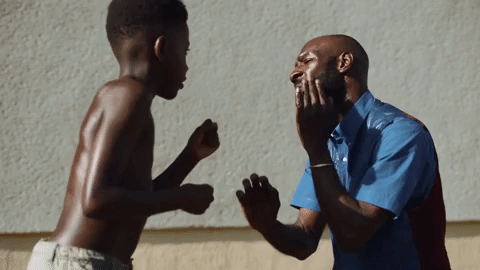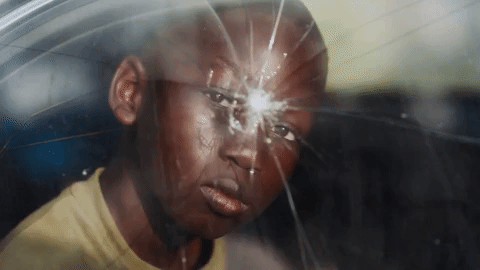In light of Childish Gambino’s newest video becoming extremely popular, I decided to wait a few days before watching. I watched Facebook and the internet explode about how complex and interesting this video was and when I finally sat down to watch it I was extremely….. disappointed. The video itself was fine and the message it had was great; but to me nothing about it particularly stood out as something that was original. The most deeply symbolic part of the piece had to be the grey cival war pants that Gambino was wearing and the Coon faces he made throughout the video.
After watching it though, I found myself needing to watch a different video, “Element” by Kendrick Lamar. When I think of something to take apart, I think of something that makes me sit down and think after viewing it; or that not only is supposed to have message but it is supposed to make you feel something that lasts even after you stop watching or viewing the piece. After watching Kendrick’s video I couldn’t help but notice the lack of nuance in Childish Gambino’s video. I spent a few days thinking about it and I couldn’t help but notice that clearly the audience’s they focused on were entirely different.

Childish Gambino made Black art for white audiences.
Kendrick Lamar made Black art for Black audiences.

Let’s quickly compare the two videos. Both are made by Black rappers speaking about violence in their community or country. It’s after this the differences appear.
Childish Gambino’s video focuses on the relationship between America, its guns, and how that relationship affects Black communities. The imagery of the mix of children dancing being in the foreground in part being there to lessen the violent scene in the background, also to show the continuing joy, and further to point out the way that people view Black people as entertainment (hence the Coon imagery) is stark and dynamic. He brings the news that we’ve all heard in to our homes making clear imagery of events and ideas that we’ve seen but sometimes refuse to put together. All of these images chaotically come together to bespell the viewer into an uncomfortable understanding of gun violence in America. Unfortunately, that feeling passes rather quickly, and Childish Gambino’s musical element does not shine through.
The rap feels like pop, watered down to be approachable by all audiences, and yet not particularly poignant, in any direction. To me, one of the most visually appealing parts is where Gambino uses hands as a gun and everyone scatters, even though there was nothing there. At that moment he pulls out a blunt and starts a smoke. It was this moment that I truly realized that this piece felt like it was pulling from elements of Kendrick’s work but didn’t have the depth of Kendrick’s work. A quote from “Fear” one of Kendrick’s songs off the “Damn” album says this: “If I could smoke fear away, I’d roll that mothafucka up– And then I’d take two puffs”. Knowing this line from Kendrick’s work even the visual imagery, seems to be in Gambino’s work.
Now, I think it’s time to take a look at the differences that take place in “Element” by Kendrick Lamar. On its own the song is beautiful and fascinating. It brings up a lot of different ideas centered around violence and ego. It’s rhythmically diverse and draws you into its story as long as you can understand what he’s talking about. See, Kendrick doesn’t code switch his music. His music is unapologetically Black and therefore uses Black English and slang to describe things. He brings up cultural touchstones that those who are non-Black may not actually understand. For instance, in the first verse, he talks about the Bible and grandmothers. A topic of conversation that’s common in Black culture is often what keeps men out of the system their grandmother’s and their belief in the Bible and God. But once that influence is gone, what is there to stop them from being sucked into the circle of violence? Another area that can be confusing or offensive for white audiences is some of his lyrical choices such as “ pussy ass nigga” and in his song fear this line is used: “Life’s a bitch, pull them panties to the side now”. Kendrick does not shy away from using these phrases. At all. His songs are filled with common Black imagery, culture, and ideas.
And now we take a look at this video for “Element” and instead of his song being mere background music for the visual art he’s creating, he directly ties in and references his music within his visual representation of his song. Kendrick’s video is a swirling whirling kaleidoscope of visual violence. The violence in his video is not glorified in any manner and should make you deeply uncomfortable.

He showcases all the different styles of violence that happened to, around and by Black men. The thing I love about those pieces is that there’s no particular start or end to the violence. This not a linear story but the static confusing mixture of elements that go into this particular relationship with violence, one that even our beloved protagonist, Kendrick himself, is not above. My favorite visual sequence that highlights this is going from Kendrick standing over a man about to hit him, into a transition of a young Black boy with his father who is egging him on to hit him and to keep his hands up. So you go from feeling disgusted with Kendrick, to feeling confused and sad for him, and then the kaleidoscope continues highlighting all the different types of trauma and violence inflicted upon young Black men. He takes his line ”damned if I do if I don’t” and fully explores each side and his visual representation of violence in the community. Is there really and truly any way to escape the violence? No. Kendrick uses of variation of a quote I heard a lot of child is “you could take the person out of the ghetto but you can’t take the ghetto out of the person”.

Both of the videos take some time to address balance within America, but it feels like Childish Gambino’s attempt to be understood by many wasn’t focused enough to create something truly poignant. To me, it ended up being a washed-out version of Kendrick’s “Element”. Kendrick choose to focus on a very narrow but important view of violence within Black male culture. He brings you into it as he is stuck in it and it shows you all the different ways that it affects him and you are affected by it. I watched this video many times now and every time I still am struck by the beauty of the piece. It always takes me a second to remember where I am, because it’s very easy to be caught up in Kendrick’s too dark, but realistic narrative. Whereas I felt like Childish Gambino’s video was much more about the entertainment factor and trying to say something while doing so (which granted may have been the point), than it is to explore and point out a problematic issue.
It’s hard to walk away from Kendrick video not feeling moved in a certain direction but it is easy to walk away from Childish Gambino’s video and 10 minutes later only remember Snippets of what happened. In part, I believe this is why “Element” won the Pulitzer Prize. As a country as we move forward I hope that we stop pigeonholing Black art into shallow representations of ourselves and of our musical art forms. I hope that instead of our Black artists needing to code switch to white audience members they learn to understand, contemplate, and empathize with a Black experience without having to water it down.
That being said if you haven’t watched Kendrick’s “Element” video you definitely should, and then write what you think in the comments below. While researching this with some help from Vartan Khachaturov, he send me a few links you should also watch:
Run the Jewels- Another Black video on violence
Matter of fact listen to all of DAMN. Again. JUST do it.
